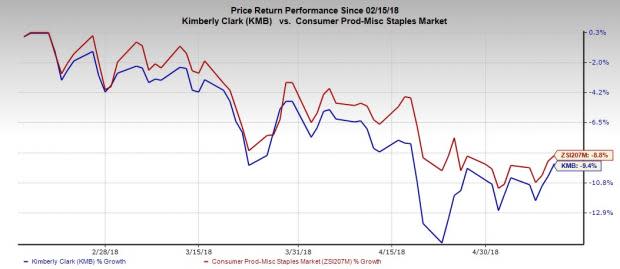Kimberly-Clark Down 9% in 3 Months: Rising Costs the Culprit?
Kimberly-Clark Corporation KMB has been sailing in troubled waters, thanks to the prolonged struggle with rising commodity costs, lower selling prices and increased competition in the diaper segment. These factors have weighed on the company’s shares that have declined 9.4% in the past three months against the industry’s fall of 8.8%.
Rising Commodity Costs
Higher input costs have been troubling Kimberly-Clark’s performance for a while. Evidently, commodity cost inflation of $175 million, stemming from greater costs of pulp and other raw materials, caused the company’s adjusted operating profit to fall 3% in the first quarter of 2018. Such factors have also been a drag on the gross margin, which contracted roughly 890 basis points (bps) to 28% in first-quarter 2018.
Prior to this, gross margin witnessed year-over-year declines of 200 bps, 60 bps and 10 bps in the preceding three quarters, respectively. To make matters worse, management anticipates input cost inflation of about $400-$550 million for 2018. We expect that such aspects will persistently dampen profits.
Apart from Kimberly-Clark, other consumer staples companies such as McCormick & Company MKC, Church & Dwight Co. CHD and TreeHouse Foods THS have also been struggling with higher commodity costs, which has been marring their profitability.
Lower Net Prices
Lower selling prices are another hurdle faced by this Zacks Rank #4 (Sell) company. In fact, during first-quarter 2018, this trend lingered and affected results in most segments. Evidently, lower net selling prices dragged sales and operating profits of Kimberly-Clark’s Personal Care as well as K-C Professional (KCP) divisions. Moreover, such deterrents limit the company’s ability to fend-off negative impacts stemming from rising commodity costs.

Prolonged Weakness in the Diaper Segment
Kimberly-Clark’s diaper segment, that holds a vital place in the Personal Care category, has been bearing the brunt of increased competition across several markets. The segment remains particularly challenged in South Korea, due to lower birth rates. The bleak performance of the diaper unit also puts the company’s market share at risk.
Any Rays of Hope Ahead?
Considering the constant struggle with rising commodity costs, it only seems natural for Kimberly-Clark to undertake aggressive measures to cut costs. The company’s Focus on Reducing Costs Everywhere or FORCE Program has generated higher cost savings each year with record amount of $450 million in 2017. In the first quarter, Kimberly-Clark generated savings of $90 million from this program and projects cost savings of $400 million in 2018.
The company estimates more than $1.5 billion to be generated over the four-year period from 2018 to 2021. These savings are expected to be achieved through management’s focus on enhancing productivity at manufacturing facilities, optimizing design and raw material expenses and attaining distribution efficiencies.
Speaking of building efficiencies, Kimberly-Clark’s recently embarked 2018 Global Restructuring Program deserves special mention. This plan is likely to enhance the company’s underlying profitability, enable it to compete better and provide greater flexibility to undertake growth-oriented investments. On a combined basis, the company expects cost savings of more than $2 billion from the FORCE program and 2018 Global Restructuring Program, over the next four years.
While Kimberly-Clark’s savings efforts seem quite robust, they are yet to fully offset the negative impacts from the aforementioned hurdles. That said, let’s wait and see if such initiatives yield favorable impacts in the forthcoming periods and lift investors’ optimism.
You can see the complete list of today’s Zacks #1 Rank (Strong Buy) stocks here.
5 Medical Stocks to Buy Now
Zacks names 5 companies poised to ride a medical breakthrough that is targeting cures for leukemia, AIDS, muscular dystrophy, hemophilia and other conditions.
New products in this field are already generating substantial revenue and even more wondrous treatments are in the pipeline. Early investors could realize exceptional profits.
Click here to see the 5 stocks >>
Want the latest recommendations from Zacks Investment Research? Today, you can download 7 Best Stocks for the Next 30 Days. Click to get this free report
Kimberly-Clark Corporation (KMB) : Free Stock Analysis Report
McCormick & Company, Incorporated (MKC) : Free Stock Analysis Report
TreeHouse Foods, Inc. (THS) : Free Stock Analysis Report
Church & Dwight Co., Inc. (CHD) : Free Stock Analysis Report
To read this article on Zacks.com click here.
Zacks Investment Research

 Yahoo Finance
Yahoo Finance 
